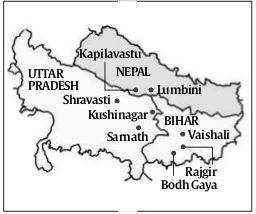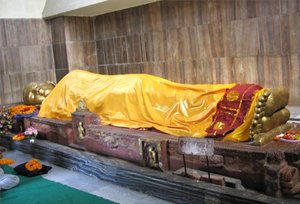Context
-
Recently, Prime Minister inaugurated the Kushinagar International Airport in Uttar Pradesh, which will help connect key Buddhist pilgrimage sites.
Key Details
Importance of Kushinagar International Airport
- The inauguration of Kushinagar International airport is set to be a landmark in the India-Sri Lanka relations.
- On the occasion of Aiprort’s inauguration, Sri Lanka will present to India photographs of two mural paintings:
- One Mural Painting shows Arahat Bhikkhu’ Mahinda, son of Emperor Ashoka delivering the message of the Buddha to King Devanampiyatissa of Sri Lanka.
- The other shows the arrival of ‘Theri Bhikkhuni’ Sanghamitta, the daughter of the Emperor, in Sri Lanka, bearing a sapling of the ‘sacred Bodhi tree’ under which Siddhārtha Gautama is believed to have attained enlightenment.
Buddhist tourism sites
- In 2016, the Ministry of Tourism announced the Buddhist Circuit as the country’s first transnational tourism circuit, covering sites in Nepal and Sri Lanka alongside those in India.
- It is surprising that while Buddhism originated in India and seven of the eight main Buddhist pilgrimage sites are in India, our country gets not even 1 per cent of Buddhist pilgrims in the world.
- The ministry’s map of the Buddhist Circuit includes Bodh Gaya, Vaishali, and Rajgir in Bihar, Kushinagar, Sarnath, and Shravasti in UP, and Lumbini in Nepal.
- The Buddha was born as the prince Siddhartha Gautama in c. 563 BC in Lumbini, and he lived until the age of 29 with his parents in the Shakya capital of Kapilavastu.
- The Buddha attained enlightenment under the Bodhi Tree in Bodh Gaya, and gave his first sermon at Sarnath near Varanasi.
- The Buddha taught in the area around Rajgir, where he was built a forest monastery by king Bimbisara of Magadha, and he lived the largest part of his life as The Buddha in Shravasti. He delivered his last sermon in Vaishali.
Back to Basics
About Kushinagar
- The present Kushinagar is identified with Kusavati (in the pre-Buddha period) and Kushinara (in the post-Buddha period).
- Kushinagar is a town in the Kushinagar district of the Indian state of Uttar Pradesh.

- An important Buddhist pilgrimage site, where Buddhists believe Gautam Buddha attained Mahaparinirvana after his death.
- An international Buddhist pilgrimage centre.
- Also at the centre of a Buddhist tourist circuit, which includes Lumbini (Nepal), Sarnath and Bodhgaya.
- Other Buddhist destinations nearby include Nalanda, Sravasti and Kapilavastu.
History of Kushinagar
- The present Kushinagar is identified with Kusavati (in the pre-Buddha period) and Kushinara (in the post-Buddha period).
- Kushinara was the capital of Mallas which was one of the sixteen mahajanpada of the 6th century BCE.
- Since then, it remained an integral part of the erstwhile empires of Maurya, Shunga, Kushana, Gupta, Harsha, and Pala dynasties.

- In the medieval period, Kushinagar had passed under the suzerainty of Kultury Kings.
- Kushinara continued to be a living city till the 12th century CE and was thereafter lost into oblivion.
- It was believed to be ruled over by a Rajput adventurer, Madan Singh, in the 15th century CE.
- Kushinagar came into prominence in the 19th century with archaeological excavations carried out by Alexander Cunningham, the first Archaeological Surveyor of India.
- It was later followed by C.L. Carlleyle who exposed the main stupa and also discovered a 10 meters long statue of reclining Buddha in 1876.
- Excavations continued till 1907 under J. Ph. Vogel, uncovering a wealth of Buddhist materials.
- Chandra Swami, a Burmese monk, came to India in 1903 and made Mahaparinirvana Temple into a living shrine.
Art and Culture UPSC 2022 : Click Here
IAS Abhiyan is now on Telegram:
- Abhiyan Official Telegram Channel: Click Here to Join
- For Mains Value Edition (Facts, Quotes, Best Practices, Case Studies): Click Here to Join
